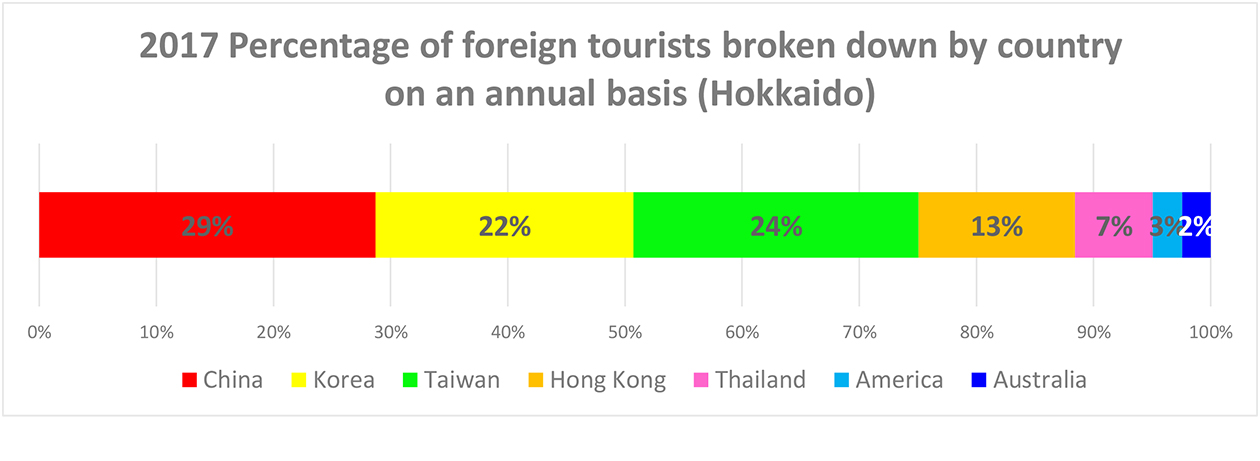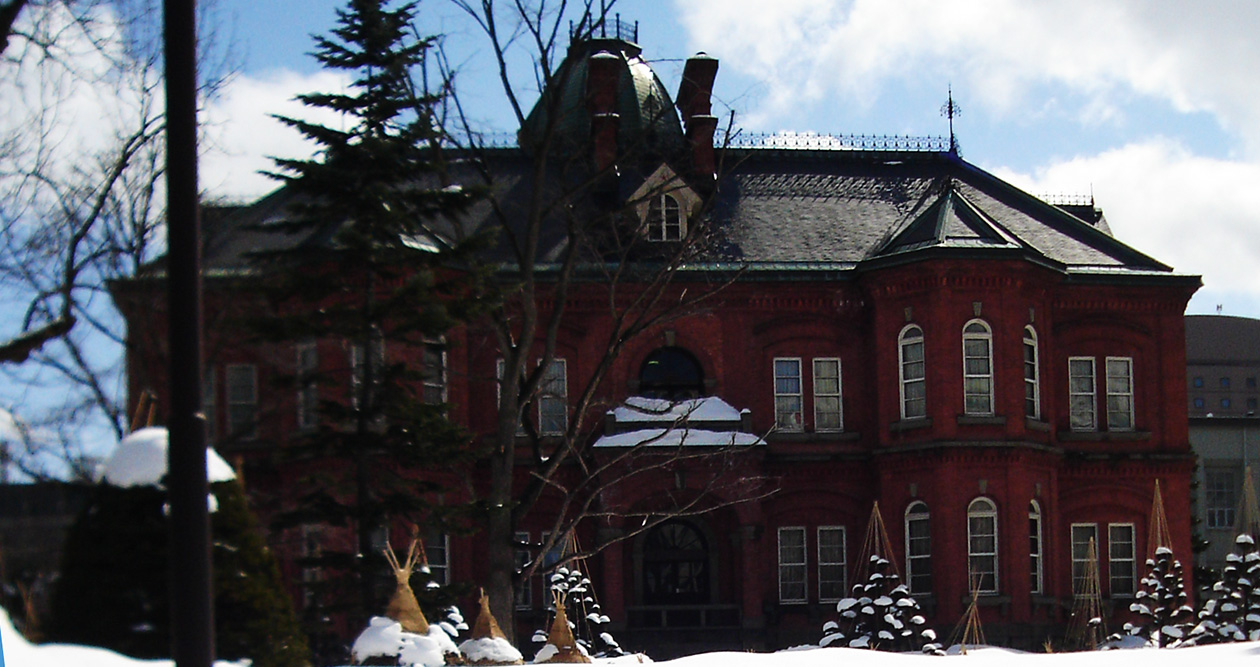Tohoku & Hokkaido Region
Hokkaido Region
Hokkaido called as “Dekkaido”, meaning “It’s huge” in Japanese, consists of large extent of lands with their own characteristics. For example, there is an event called “Snow festival” in Sapporo. Many “Inbound” tourists visit there to see the snow statues and ice sculptures at that time. According to the taxi driver in Sapporo, more “Inbound” tourists can be seen during the festival.
Recently, they also visit Hokkaido besides the festival season.
For example, tourists from Europe or the United States who visit Sapporo's clock tower, or tourists from China and other countries who visit Japan to buy a lot of things at the drug stores.
Hokkaido has a high demand for “Inbound”. It has the second most tourist information centers in Japan and the number of its overnight visitors is the third highest. It also holds many airports and ports. More than 75% of the signs are written in English. In Sapporo Snow Festival, “Cloud Translation”, the system introducing its attractiveness, is introduced in Chinese, Korean and Thai languages.

Interviews
We asked the people in Hokkaido the following questions!
Q: Are there places where many overseas tourists visit in Sapporo?
A: Westerners like to visit the historical, traditional and cultural places such as the clock tower, Former Hokkaido Government Office Building (Red Brick Office), Okurayama ski jump viewing point, Sapporo Brewery & Museum. On the other hand, Asian people, especially Chinese and Koreans prefer buying plenty of goods at the drugstores (food and cosmetics) or at electric appliance stores (rice cooker and game devices) to sightseeing.

A: We speak broken English to westerners, Taiwanese, Malaysians and Vietnamese. As for Chinese, Koreans, we use bidirectional translator on smartphones
Q: Is there a particular events when you have many overseas visitors?
A: We have many on“Snow festival” period.
Q: Where are they from?
A: Absolutely from China and Korea taking up 70 percent share of the total overseas visitors. The number of Malaysians and Vietnamese are increasing gradually.
Q: Is there a difference between today’s number of “Inbound” visitors and that of ten years ago?
A: Ten years ago, we had many of tourists around “Snow festival” period, which were mainly from western countries such as the U.S, the U.K. However, because of the promotion strategy set by Prime Minister Abe toward overseas tourists, nondurable goods such as cosmetics and beverages are subject to tax exemption, which encouraged Chinese people’s eagerness of buying things and multiplied the number of tourists.

Tohoku Region
The number of “Inbound” tourists is increasing in Tohoku Region. The number of overnight visitors including “Inbound” tourists has reached up to 1,210,000 people in 2018, increasing 250,000 people from 2017 which had only 960,000.
This bump is realized by the gateway strategy connecting international airports, such as Narita and Haneda, to the domestic ones or the effective tourists gathering by cruise ships. Being attractive in its rich nature, the areas in Tohoku are making effort to set signs written in English for “Inbound” tourists traveling with rental cars. For instance, since signs using Roman characters called “Romaji” is not easy to understand, they are being replaced by English writings. More efforts have been made such as writing map symbols next to the graphical names in Japanese so as to be visually friendlier to the visitors.
Besides the transportation aspect, Tohoku Region is doing a lot of work in other areas, such as installing multi-language translation devices or hiring interpreter-guides. When “Inbound” tourists visit Japan, the biggest problem they encounter is the language barrier. In order to eliminate this obstacle as much as possible, they are taking measures such as using apps. However, there are some translation errors depending on the people’s tones and pronunciations. Therefore, its improvement will be their future task. Furthermore, there are many cases when Wi-Fi is not available especially in the rural areas in the mountains. This means they cannot use the Internet, which is very important for people overseas to travel in another country and to communicate with the local Japanese. The project creating an environment where people can smoothly access the Internet and increasing Wi-Fi enabled places is underway.
Tohoku Region is an appealing place with their traditional crafts, World Heritage Sites, and festivals, etc. Efforts in various industries are incorporated in their daily lives.

We asked the people in Hokkaido the following questions!
At Yonezawa Michi-no-Eki (roadside station) in Yamagata prefecture
Q: How may “Inbound” tourists do you have a year?
A: Usually about 120 a day, which makes 44,000 a year. It is about one percent of the total visitors.
Q: Which country are they from the most?
A: From Asian countries such as Taiwan, China. Many of them have friends here and travel around by their cars or by rental cars.

A famous hotel in Fukushima prefecture
Q: How may “Inbound” tourists do you have a year?
A: Approximately 60,000 a year. Our total visitors are about 260,000 a year, so it is about 30 percent of the total visitors.
Q: Which country are the most guests from?
A: They are mostly from western countries, China and Vietnam, which occupies 20 percent each of the total number of “Inbound” tourists. Tourists from Vietnam tends to increase yearly. Moreover, nearly 10 percent of them are from Africa.
Q: What efforts do you make towards “Inbound” tourists?
A: We provide packaged tours and limited-time-only bus campaigns which utilize governmental gateway strategy in cooperation with the low cost carriers (LCC). One of the reason why we have many tourists from Vietnam is that there are direct flight from there to Tohoku area.
We not only speak in English to the guests but also we host them in Chinese (Mandarin, Cantonese, Shanghainese and Taiwanese), Vietnamese, Italian. We also hire staffs from the U.S, and Africa such as Ghana to create a comfortable environment for overseas visitors, which may be difficult by the reception of Japanese staffs.
Q: What services are you thinking of in the future?
A: Although called “inbound”, it is difficult to focus on every single countries in the world providing packaged tours. Therefore, we will assign the most importance on Asian countries in cooperation with the airline companies to promote our activities toward overseas tourists.

